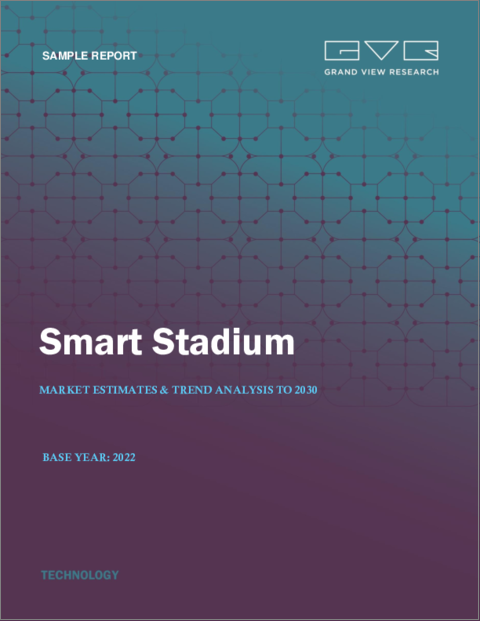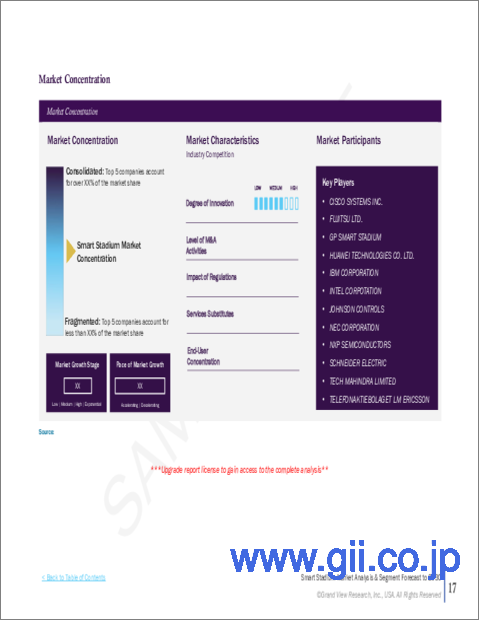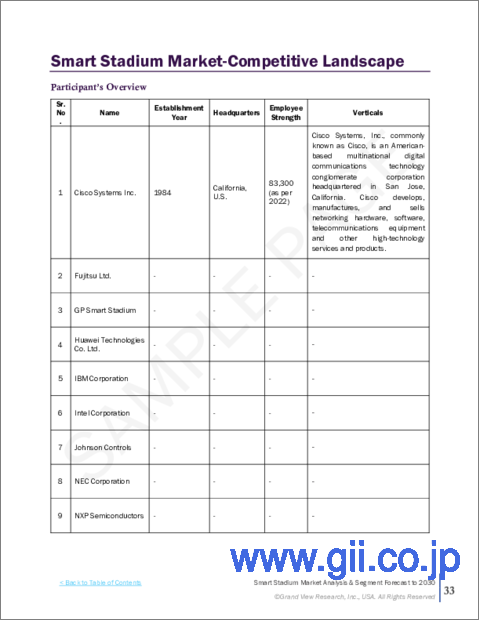|
|
市場調査レポート
商品コード
1321505
スマートスタジアムの市場規模、シェア、動向分析レポート:コンポーネント別、展開タイプ別、地域別、セグメント予測:2023年~2030年Smart Stadium Market Size, Share & Trends Analysis Report By Component (Software, Services), By Deployment Type (On-premise, Cloud), By Region, And Segment Forecasts, 2023 - 2030 |
||||||
カスタマイズ可能
|
|||||||
| スマートスタジアムの市場規模、シェア、動向分析レポート:コンポーネント別、展開タイプ別、地域別、セグメント予測:2023年~2030年 |
|
出版日: 2023年07月25日
発行: Grand View Research
ページ情報: 英文 140 Pages
納期: 2~10営業日
|
- 全表示
- 概要
- 図表
- 目次
スマートスタジアム市場の成長と動向
Grand View Research, Inc.の最新レポートによると、世界のスマートスタジアム市場規模は、2023年から2030年にかけてCAGR 20.6%で成長し、2030年には293億9,000万米ドルに達すると推定されます。
この成長は、スタジアムにおけるファン体験の向上、安全性の改善、運営効率の向上への注目が高まっていることに起因しています。自動発券システムからインタラクティブなデジタルディスプレイまで、スマート技術の採用により、スタジアムはパーソナライズされた体験でファンをもてなし、全体的な満足度を向上させることができます。バーチャルリアリティ体験やリアルタイム分析など、現在進行中の技術的進歩は、スマートスタジアム業界に新たな成長の道を開くと期待されています。
また、イベントの進行に関するデータをリアルタイムで配信し、出演者やチームとファンとの交流をより有意義なものにすることで、顧客サービスを向上させるハイエンド技術の導入も市場の成長を後押ししています。これらのテクノロジーにより、スタジアムは運営に関する貴重な洞察を得ることができ、最大の効率を得るためにリソースを最適化する優れた方法を採用することができます。
データ主導の運営に対する需要の高まりや、今後予定されている国際的・国内的なスポーツイベントが、スマートスタジアムの需要を後押ししています。現在、世界中のいくつかのスタジアムが、次世代の観戦体験、ファン体験、スマートパーキング、運営効率、セキュリティ強化などを提供するために改修されています。スマートスタジアムは、駐車場ソリューション、監視ソリューション、センサー、デジタル標識などを備えています。これらのソリューションは、売店の行列、スタジアム内の商品価格、駐車場の空き状況などの情報をリアルタイムで提供し、ファンの全体的な体験を向上させる。
スマートスタジアム業界の見通しを高めるもう一つの重要な要因は、持続可能な電力源によって電力消費量とカーボンフットプリントを削減するために、スタジアムの所有者がグリーンイニシアチブを採用していることです。例えば、ナショナル・ホッケー・リーグ(NHL)は、会場のカーボンフットプリントを測定し、持続可能性目標のためのベストプラクティスに関する洞察を得るために、データと分析ソリューションを導入しました。同リーグはパートナーであるSAPと協力し、サステナビリティ・プラットフォーム「NHL Venue Metrics」を開発しました。
スマートスタジアム市場レポートハイライト
- コンポーネントに基づくと、ソフトウェアセグメントは2022年に61.0%の売上シェアを獲得しました。
- 展開に基づくと、クラウド分野は予測期間中21.0%以上のCAGRで成長すると推定されます。クラウドの導入により、スタジアムのような複雑なインフラをより効率的に運用できるようになり、新たな機会が創出され、数多くの重要な利点により新たな収益の流れが開かれます。
- アジア太平洋地域は、日本、インド、ASEAN、オーストラリアのスタジアムで、安全・セキュリティの向上とファン体験の向上を目的としたデジタル技術の採用が急激に増加していることから、推定・予測期間のCAGRは23.0%と大幅に成長します。
目次
第1章 調査手法と範囲
- 市場セグメンテーションと範囲
- 市場の定義
- 情報調達
- 情報分析
- 市場の形成とデータの視覚化
- データの検証と公開
第2章 エグゼクティブサマリー
第3章 業界の展望
- 市場系統の見通し
- 業界のバリューチェーン分析
- 市場力学
- 市場促進要因の分析
- 市場抑制要因分析
- 市場の課題
- 市場機会
- 業界分析ツール
- ポーターの分析
- マクロ経済分析
- スマートスタジアム市場の主な動向
- スマートスタジアム市場- COVID-19による影響分析
第4章 スマートスタジアム市場:コンポーネントの推定・動向分析
- コンポーネントの変動分析と市場シェア、2022年と2030年
- コンポーネント別
- ソフトウェア
- サービス
第5章 スマートスタジアム市場:展開タイプの推定・動向分析
- 展開タイプの変動分析と市場シェア、2022年と2030年
- 展開タイプ別
- オンプレミス
- クラウド
第6章 スマートスタジアム市場:地域別の推定・動向分析
- スマートスタジアム市場:地域別展望
- 北米
- 北米のスマートスタジアム市場の推定と予測、2018~2030年
- 米国
- カナダ
- メキシコ
- 欧州
- 欧州のスマートスタジアム市場の推定と予測、2018~2030年
- 英国
- ドイツ
- フランス
- イタリア
- アジア太平洋地域
- アジア太平洋地域のスマートスタジアム市場の推定と予測、2018~2030年
- 中国
- インド
- 日本
- 韓国
- 南米
- 南米のスマートスタジアム市場の推定と予測、2018~2030年
- ブラジル
- アルゼンチン
- 中東およびアフリカ(MEA)
- MEAのスマートスタジアム市場の推定と予測、2018~2030年
- サウジアラビア
- アラブ首長国連邦
- 南アフリカ
第7章 競合情勢
- 主な参加者
- Cisco Systems, Inc.
- Fujitsu Ltd.
- IBM Corporation
- Intel Corporation
- NEC Corporation
- Johnson Control
- NXP Semiconductors
- Schneider Electric
- Tech Mahindra Limited
- Telefonaktiebolaget LM Ericsson
- 主要市場参入企業による最近の展開と影響
- 企業の分類
- 参入企業の概要
- 財務実績
- 製品のベンチマーク
- 企業ヒートマップ分析
- 企業の市場シェア分析、2022年
- 戦略マッピング
- 拡大
- 合併と買収
- コラボレーション
- 新製品の発売
- 研究開発
List of Tables
- Table 1 Smart stadium market Revenue Estimates and Forecast, By Component, 2018 - 2030 (USD Million)
- Table 2 Smart stadium market Revenue Estimates and Forecast, By Deployment Type, 2018 - 2030 (USD Million)
- Table 3 Recent Developments & Impact Analysis, By Key Market Participants
- Table 4 Key company categorization
- Table 5 Company Heat Map Analysis
- Table 6 Key companies undergoing expansions
- Table 7 Key companies involved in mergers and acquisitions
- Table 8 Key companies undergoing collaborations
- Table 9 Key companies launching new products
- Table 10 Key Companies undertaking R&D activities
List of Figures
- Fig. 1 Smart stadium market Segmentation
- Fig. 2 Information Procurement
- Fig. 3 Data Analysis Models
- Fig. 4 Market Formulation and Validation
- Fig. 5 Data Validating & Publishing
- Fig. 6 Market Snapshot
- Fig. 7 Segment Snapshot
- Fig. 8 Competitive Landscape Snapshot
- Fig. 9 Smart stadium market Value, 2022 (USD Million)
- Fig. 10 Workload Scheduling & Automation- Industry Value Chain Analysis
- Fig. 11 Smart stadium market Dynamics
- Fig. 12 Key Market Driver Impact
- Fig. 13 Key Market Restraint Impact
- Fig. 14 Smart stadium market: PORTER's Five Forces Analysis
- Fig. 15 Smart stadium market: Macroeconomic Analysis
- Fig. 16 Smart Stadium Market, by Component, Key Takeaways
- Fig. 17 Component movement analysis & market share, 2022 & 2030 (USD Million)
- Fig. 18 Smart Stadium Market, by Deployment Type, Key Takeaways
- Fig. 19 Deployment Type movement analysis & market share, 2022 & 2030 (USD Million)
- Fig. 20 Regional market size estimates & forecasts, 2022 & 2030 (USD Million)
- Fig. 21 Regional movement analysis & market share, 2022 & 2030 (USD Million)
- Fig. 22 Key Company Categorization
- Fig. 23 Company Market Share Analysis, 2022
- Fig. 24 Strategic framework
Smart Stadium Market Growth & Trends
The global smart stadium market size is estimated to reach USD 29.39 billion by 2030, growing at 20.6% CAGR from 2023 to 2030, according to a new report by Grand View Research, Inc. The growth can be attributed to the increasing focus on providing enhanced fan experience, improved safety, and increased operational efficiency at stadiums. The adoption of smart technology from automated ticketing systems to interactive digital displays, allows stadiums to host fans with personalized experiences and improve their overall satisfaction. The ongoing technological advancements such as virtual reality experiences and real-time analytics are expected to open new growth avenues for the smart stadium industry.
The growth of the market is also driven by the implementation of high-end technologies to improve customer service by delivering real-time data on the progression of events and facilitating fan interaction with the performer or teams in a more meaningful way. These technologies allow stadiums to gain valuable insights into their operations and employ better ways of optimizing their resources for maximum efficiency.
The rising demand for data-driven operations and upcoming international and national sports events are impelling the demand for smart stadiums. Several stadiums across the world are now being renovated to provide next-generation viewing experiences, fan experience, smart parking, operational efficiency, enhanced security, etc. Smart stadiums are equipped with parking solutions, surveillance solutions, sensors, digital signs, etc. These solutions provide real-time information, including lines at concession stands, in-stadium merchandise pricing, and availability of parking, which enhances the overall experience for the fans.
Another crucial factor enhancing the smart stadium industry outlook is the adoption of green initiatives by stadium owners to reduce power consumption and carbon footprint with sustainable sources of electricity. For instance, the National Hockey League (NHL) has deployed data and analytics solutions to measure the carbon footprint of its venues and to gain insights into the best practices for its sustainability goals. The league has worked with partner SAP to develop a sustainability platform, NHL Venue Metrics, that can be used by the teams and their venue partners for data collection, validation, reporting, and insights.
Smart Stadium Market Report Highlights
- Based on component, the software segment captured a revenue share of 61.0% in 2022, owing to rising adoption driven by the increased significance of improving fan engagement to provide an enhanced experience
- Based on deployment, the cloud segment is estimated to grow at a CAGR of over 21.0% over the forecast period. Cloud deployment can allow complex infrastructure such as stadiums to operate more effectively, creating new opportunities, and opening new streams of revenues due to its numerous and important advantages
- Asia Pacific is estimated to grow at a significant CAGR of 23.0% over the forecast period owing to a drastic rise in the adoption of digital technologies in stadiums across Japan, India, ASEAN, and Australia to increase safety & security and improve fan experience
Table of Contents
Chapter 1. Methodology and Scope
- 1.1. Market Segmentation & Scope
- 1.2. Market Definition
- 1.3. Information Procurement
- 1.3.1. Purchased Database
- 1.3.2. GVR's Internal Database
- 1.3.3. Secondary Sources & Third-Party Perspectives
- 1.3.4. Primary Research
- 1.4. Information Analysis
- 1.4.1. Data Analysis Models
- 1.5. Market Formulation & Data Visualization
- 1.6. Data Validation & Publishing
Chapter 2. Executive Summary
- 2.1. Market Snapshot
- 2.2. Segment Snapshot
- 2.3. Competitive Landscape
Chapter 3. Industry Outlook
- 3.1. Market Lineage Outlook
- 3.2. Industry Value Chain Analysis
- 3.3. Market Dynamics
- 3.3.1. Market driver analysis
- 3.3.2. Market restraint analysis
- 3.3.3. Market challenges
- 3.3.4. Market opportunities
- 3.4. Industry Analysis Tools
- 3.4.1. PORTER'S Analysis
- 3.4.2. MACROECONOMIC Analysis
- 3.5. Key Trends in Smart Stadium Market
- 3.6. Smart Stadium Market- COVID-19 Impact Analysis
Chapter 4. Smart Stadium Market: Component Estimates & Trend Analysis
- 4.1. Component Movement Analysis & Market Share, 2022 & 2030
- 4.2. Smart Stadium Market Estimates & Forecast, By Component (USD Million)
- 4.2.1. Software
- 4.2.2. Services
Chapter 5. Smart Stadium Market: Deployment Type Estimates & Trend Analysis
- 5.1. Deployment Type Movement Analysis & Market Share, 2022 & 2030
- 5.2. Smart Stadium Market Estimates & Forecast, By Deployment Type (USD Million)
- 5.2.1. On-Premise
- 5.2.2. Cloud
Chapter 6. Smart Stadium Market: Regional Estimates & Trend Analysis
- 6.1. Smart Stadium Market: Regional Outlook
- 6.2 North America
- 6.2.1 North America smart stadium market estimates & forecasts, 2018 - 2030 (USD Million)
- 6.2.2 U.S.
- 6.2.2.1 U.S. smart stadium market estimates & forecasts, 2018 - 2030 (USD Million)
- 6.2.3 Canada
- 6.2.3.1 Canada smart stadium market estimates & forecasts, 2018 - 2030 (USD Million)
- 6.2.4 Mexico
- 6.2.4.1 Mexico smart stadium market estimates & forecasts, 2018 - 2030 (USD Million)
- 6.3 Europe
- 6.3.1 Europe smart stadium market estimates & forecasts, 2018 - 2030 (USD Million)
- 6.3.2 UK
- 6.3.2.1 UK smart stadium market estimates & forecasts, 2018 - 2030 (USD Million)
- 6.3.3 Germany
- 6.3.3.1 Germany smart stadium market estimates & forecasts, 2018 - 2030 (USD Million)
- 6.3.4 France
- 6.3.4.1 France smart stadium market estimates & forecasts, 2018 - 2030 (USD Million)
- 6.3.5 Italy
- 6.3.5.1 Italy smart stadium market estimates & forecasts, 2018 - 2030 (USD Million)
- 6.4 Asia Pacific
- 6.4.1 Asia Pacific smart stadium market estimates & forecasts, 2018 - 2030 (USD Million)
- 6.4.2 China
- 6.4.2.1 China smart stadium market estimates & forecasts, 2018 - 2030 (USD Million)
- 6.4.3 India
- 6.4.3.1 India smart stadium market estimates & forecasts, 2018 - 2030 (USD Million)
- 6.4.4 Japan
- 6.4.4.1 Japan smart stadium market estimates & forecasts, 2018 - 2030 (USD Million)
- 6.4.5 South Korea
- 6.4.5.1 South Korea smart stadium market estimates & forecasts, 2018 - 2030 (USD Million)
- 6.5 South America
- 6.5.1 South America smart stadium market estimates & forecasts, 2018 - 2030 (USD Million)
- 6.5.2 Brazil
- 6.5.2.1 Brazil smart stadium market estimates & forecasts, 2018 - 2030 (USD Million)
- 6.5.3 Argentina
- 6.5.3.1 Argentina smart stadium market estimates & forecasts, 2018 - 2030 (USD Million)
- 6.6 Middle East and Africa (MEA)
- 6.6.1 MEA smart stadium market estimates & forecasts, 2018 - 2030 (USD Million)
- 6.6.2 Saudi Arabia
- 6.6.2.1 Saudi Arabia smart stadium market estimates & forecasts, 2018 - 2030 (USD Million)
- 6.6.3 UAE
- 6.6.3.1 UAE smart stadium market estimates & forecasts, 2018 - 2030 (USD Million)
- 6.6.4 South Africa
- 6.6.4.1 South Africa smart stadium market estimates & forecasts, 2018 - 2030 (USD Million)
Chapter 7. Competitive Landscape
- 7.1 Key Participants
- 7.1.1. Cisco Systems, Inc.
- 7.1.2. Fujitsu Ltd.
- 7.1.3. IBM Corporation
- 7.1.4. Intel Corporation
- 7.1.5. NEC Corporation
- 7.1.6. Johnson Control
- 7.1.7. NXP Semiconductors
- 7.1.8. Schneider Electric
- 7.1.9. Tech Mahindra Limited
- 7.1.10. Telefonaktiebolaget LM Ericsson
- 7.2 Recent Development & Impact, By Key Market Participants
- 7.3 Company Categorization
- 7.4 Participant's Overview
- 7.5 Financial Performance
- 7.6 Product Benchmarking
- 7.7 Company Heat Map Analysis
- 7.8 Company Market Share Analysis, 2022
- 7.9 Strategy Mapping
- 7.9.1 Expansion
- 7.9.2 Mergers & acquisition
- 7.9.3 Collaborations
- 7.9.4 New product launches
- 7.9.5 Research & Development





